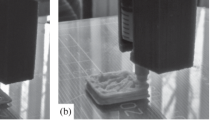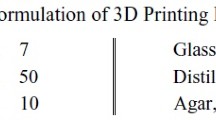The problems of creating three-dimensional structures with a prescribed architecture based on pyrophosphate ceramic by the consumable additive method are studied. The problems of filling with a powder precursor the polymer negative printed in a 3D printer as well as preserving the structure of the material in the process of removing the polymer were solved. The processes of sintering of ceramic materials as well as the mechanical characteristics of the obtained materials are studied.






Similar content being viewed by others
References
M. Bohner, “Resorbable biomaterials as bone graft substitutes,” Materials Today, 13(1 – 2), 24 – 30 (2010).
J. H. Lee, B. S. Chang, U. O. Jeung, et al., “The first clinical trial of beta-calcium pyrophosphate as a novel bone graft extender in instrumented posterolateral lumbar fusion,” Clinics in Orthopedic Surgery, 3(3), 238 – 244 (2011).
T. V. Safronova, V. I. Putlyaev, Ya. Yu. Filippov, et al., “Porous ceramic based on calcium pyrophosphate,” Novye Ogneupory, No. 1, 46 – 51 (2015).
W. L. Hill, G. T. Faust, and D. S. Reynolds, “System CaO–P2O5,” Am. J. Sci., 457 – 477 (1944).
J. Berak and T. Znamierowska, “System Na2O–CaO–P2O5,” Rocz. Chem., 46(11), 1921 – 1929 (1972).
S. M. Barinov and V. S. Komlev, “Approached to the creation of porous materials based on calcium phosphates, intended for regeneration of bone tissue,” Neorg. Mater., 52(4), 383 – 391 (2016).
S. S. Crump, Apparatus and Method for Creating Three-Dimensional Objects, Book Apparatus and Method for Creating Three-Dimensional Objects, US Patent 5,121,329, June 9, 1992.
V. M. Ievlev, V. I. Putlyaev, T. V. Safronova, and P. V. Evdokimov, “Additive technologies for making highly permeable inorganic materials with tailored morphological architectonics for medicine,” Inorg. Mater., 51(13), 1295 – 1313 (2015).
W. M. Sigmund, N. S. Bell, and L. Bergstorm, “Formation characterization and rheological properties of zirconia and ceria-stabilized zirconia,” J. Am. Ceram. Soc., 83(7), 1557 – 1574 (2000).
N. K. Orlov, V. I. Putlyaev, P. V. Evdokimov, et al., “Resorption of calcium-phosphate bioceramic Ca3–xM2x(PO4)2 (M = Na, K) in model solutions,” Neorg. Mater., 54(5), 523 – 531 (2018).
This work was performed using equipment acquired through the development program at Moscow University.
This work was financed by the RFBR (grant No. 18-33-00789mol a, 16-38-60203, 18-08-01473) as well as the grant No. D2-17/013-03 (work competition established by O. V. Deripaska for students, graduate students, and young scientists at Moscow State University).
Author information
Authors and Affiliations
Corresponding author
Additional information
Translated from Steklo i Keramika, No. 11, pp. 35 – 39, November, 2018.
Rights and permissions
About this article
Cite this article
Filippov, Y.Y., Vlasikhina, A.A., Klimashina, E.S. et al. Creation of Three-Dimensional Ceramic Structures with Prescribed Architecture Based on the System Ca2P2O7–CaNa2P2O7. Glass Ceram 75, 446–450 (2019). https://doi.org/10.1007/s10717-019-00109-2
Published:
Issue Date:
DOI: https://doi.org/10.1007/s10717-019-00109-2




